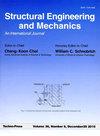Analytical model for the basement wall horizontally supported by flexible floor diaphragms
IF 2.2
4区 工程技术
Q2 ENGINEERING, CIVIL
引用次数: 0
Abstract
Subterranean floors are treated as the rigid lateral support in the current practice for the basement wall design. The structural performance of the basement wall will be influenced by the floor openings, which are inevitable to satisfy building functional requirements. An analytical model for the basement wall being presented is able to analyze the effect of such opening quantitatively. The magnitude of the horizontal support stiffness is determined based on deformation analysis of the diaphragm opening area. Idealized models of the basement wall are continuous beams with various degrees of indeterminacy. The force method is used to deduce the functions for internal forces acting towards the basement wall. The proposed analytical model is verified with results derived by finite element analyses through consideration of various factors, including various numbers of stories, combinations of beam-slab sections, and percentages of floor opening dimensions. The maximum deviations on critical design sections for all prototype basement structures are less than 15.99%. Comparisons with conventional rigid support models are also performed, providing an estimation of the effect of the opening on the mechanical behavior of the basement wall.柔性楼板横隔板水平支承的地下室墙解析模型
在目前的地下室墙体设计实践中,地下楼板被视为刚性横向支撑。地下室墙体的结构性能会受到楼层开口的影响,这是满足建筑功能要求的必然要求。建立了地下室墙体的分析模型,可以定量地分析这种开洞的影响。通过对膜片开口区域的变形分析,确定了水平支承刚度的大小。地下室墙的理想模型是具有不同不确定度的连续梁。用力法推导了作用于基底墙的内力函数。通过考虑各种因素,包括不同层数、梁-板截面组合和楼板开口尺寸百分比,用有限元分析得出的结果验证了所提出的分析模型。所有原型基底结构在临界设计截面上的最大偏差均小于15.99%。还与传统的刚性支撑模型进行了比较,提供了对开孔对地下室墙力学行为影响的估计。
本文章由计算机程序翻译,如有差异,请以英文原文为准。
求助全文
约1分钟内获得全文
求助全文
来源期刊

Structural Engineering and Mechanics
工程技术-工程:机械
CiteScore
3.80
自引率
18.20%
发文量
0
审稿时长
11 months
期刊介绍:
The STRUCTURAL ENGINEERING AND MECHANICS, An International Journal, aims at: providing a major publication channel for structural engineering, wider distribution at more affordable subscription rates; faster reviewing and publication for manuscripts submitted; and a broad scope for wider participation.
The main subject of the Journal is structural engineering concerned with aspects of mechanics. Areas covered by the Journal include:
- Structural Mechanics
- Design of Civil, Building and Mechanical Structures
- Structural Optimization and Controls
- Structural Safety and Reliability
- New Structural Materials and Applications
- Effects of Wind, Earthquake and Wave Loadings on Structures
- Fluid-Structure and Soil-Structure Interactions
- AI Application and Expert Systems in Structural Engineering. Submission of papers from practicing engineers is particularly encouraged.
 求助内容:
求助内容: 应助结果提醒方式:
应助结果提醒方式:


